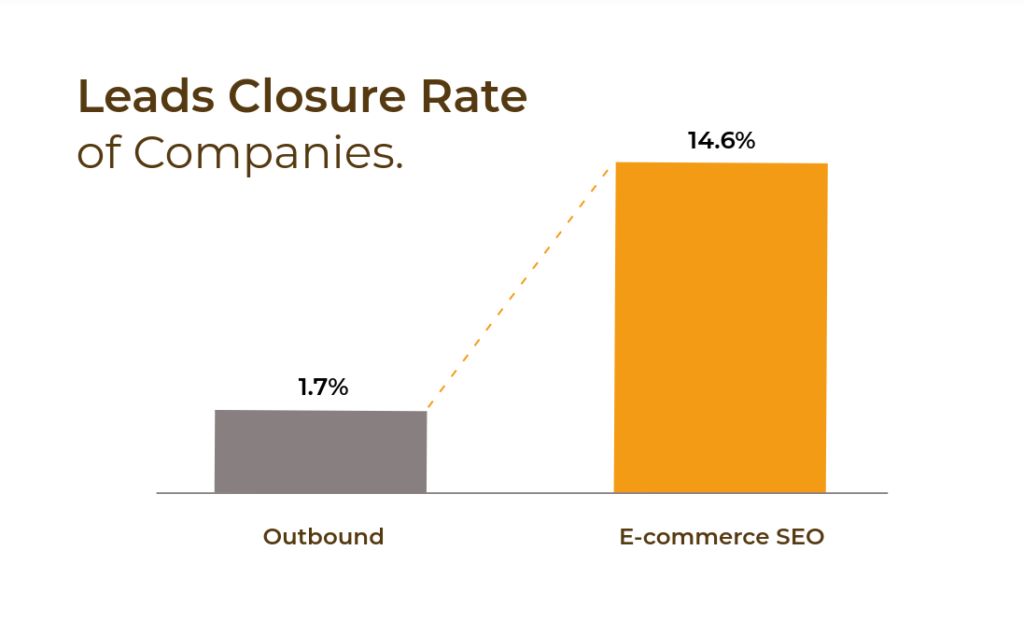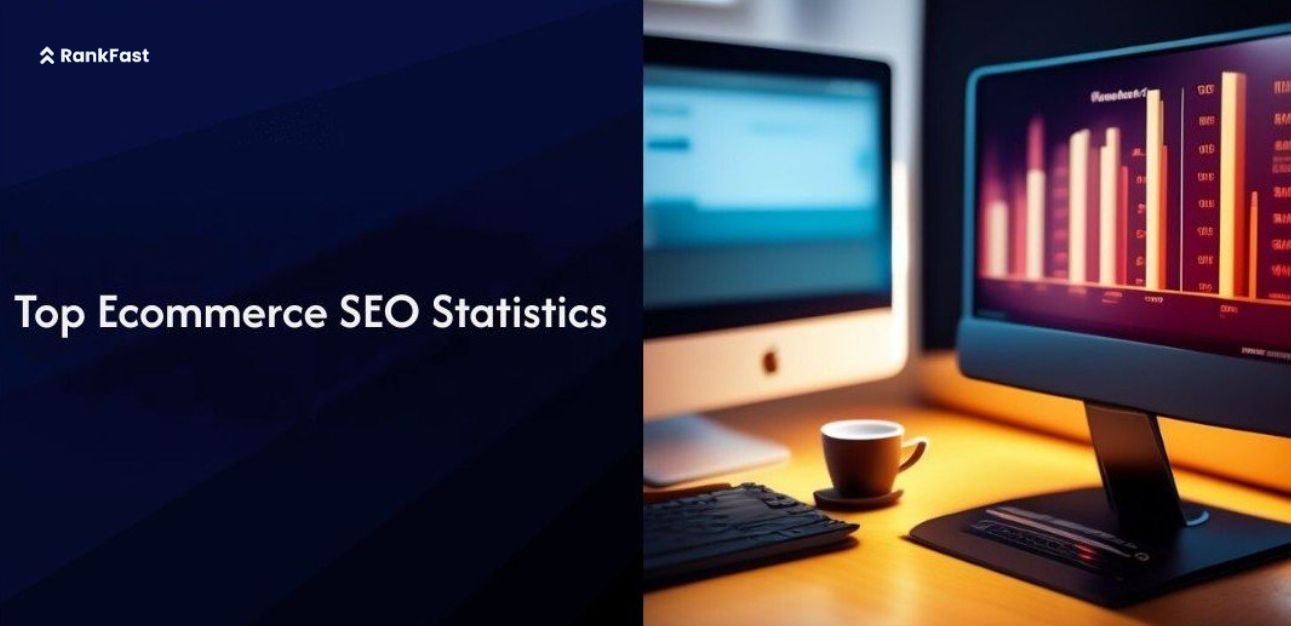eCommerce SEO can be a huge advantage for online stores. While SEO offers one of the best returns compared to other marketing strategies, many store owners overlook it and focus on social media or paid ads, which need constant work and cost a lot but don’t always bring steady income. In fact, businesses spend billions on these methods every year.
SEO, on the other hand, requires less ongoing effort once your site ranks well and can drive sales without extra expenses. In this blog, we’ll look into key eCommerce SEO statistics to help you understand the industry better.
Leading eCommerce SEO Statistics
Following are the eCommerce SEO research statistics that you will find interesting:
Impact of eCommerce Blogging
1. As per a report by LifeSight, blog-equipped e-commerce websites get 434% more indexed pages.
2. As per a report by Statista in 2023, e-commerce accounted for 19.4 percent of total retail sales worldwide.
3. Among B2B marketers, 54% rank producing interesting content as their top SEO strategy.
4. A recent study of 2,300 businesses found that businesses with blogs generate 126% more leads than those without.
Our Viewpoint

Blogs cannot be overlooked in eCommerce SEO while increasing the number of indexed pages on a website. Content is a key factor, and many B2B marketers are focused on producing relevant content. Without a blog, websites miss out on better indexing and search visibility while competitors continue to gain traffic. Starting a blog can help improve SEO through additional indexed pages.
SEO and Conversion in E-Commerce
1. The average conversion rate for e-commerce SEO is 2.35%
2. 23.6% of online purchases have a clear correlation with organic traffic.
3. Search engines are used by 44% of individuals to begin their online purchasing.
4. Google SERP results show that the top result has, on average, 3.8 times more backlinks than the other results (2–10).
5. The top page of search results receives 95% of all search traffic.
6. More than three terms are used in 70% of searches.
7. Website optimization is present in 33% of small-to-midsize companies.
8. Mobile devices are used for 61% of Google searches.
9. Google’s organic traffic accounts for at least 43% of all e-commerce traffic.
10. The average increase in click-through rate that occurs when you go up one search engine results page (SERP) is 30.8%.
11. Statista reports that in 2023, 68% of online shoppers in the U.S. utilized Google to research products before making purchases online.
12. Companies who blog get 97% more links to their websites.
13. Businesses that blog get 55% more website visitors than businesses that don’t.
14. Moving up 1 search position will boost your click-through rate by an average of 30.8%.

15. Outbound leads’ closure rate is 1.7%, whereas e-commerce SEO leads’ close rate is 14.6%.
16. The click-through rate of e-commerce websites using schema markup is 30% higher.
17. Compared to social media, search engines drive 300% more traffic to websites.
18. Sales from leads produced by SEO are converted at a rate of 14.6%.
19. Compared to plain text, video content has a 50 times higher chance of driving organic search results.
20. 53% of marketers saw their engagement rates increase after updating old content, while 49% saw an increase in traffic.
21. The source of 43% of e-commerce traffic is natural Google search results.
22. Google Search, Maps, and Images together account for at least 92.96% of all organic traffic worldwide.
23. According to 73% of marketers, SEO is a highly efficient way to increase sales.
24. Conversion rates can rise by 30% when product descriptions are used correctly.
25. In A report by Semrush, 80% of SEO experts believe SEO tools are extremely effective.
26. According to 58% of marketers, inbound strategies provide sales teams with the best quality leads.
27. A minimum of one video may be found in around 25% of Google searches.
28. By 2030, global PPC ad spending is projected to exceed $150 billion.
29. B2C eCommerce sites convert from SEO at an average of 1.3%, while B2B eCommerce SEO conversion skews a bit higher, at 1.85%.
30. Digital trade is expected to reach $6.5 trillion in 2023.
31. High-quality content is the most effective SEO strategy, according to 59% of B2C marketers.
32. The ROI on e-commerce email marketing is typically 4400%.
33. Live chat boosts conversion rates by 10% for e-commerce companies.
34. According to 61% of businesses, enhancing SEO and their organic presence is their top goal for inbound marketing.
35. By the end of 2024, e-commerce is expected to make up 20.1% of all retail sales worldwide.
36. The average conversion rate for e-commerce SEO is 2.4%.
37. With 57% of B2B marketers highlighting SEO as their primary lead source.
38. A study suggests that 57% of B2B respondents consider the lack of a dedicated SEO manager as the biggest challenge to SEO and content marketing.
Our Viewpoint
These Days, SEO is super important in e-commerce, where clicks and sales matter the most. These numbers show growth and profit, like a 125% boost in income or a 30% higher click-through rate with schema markup. The ones who really understand SEO will lead the way as e-commerce keeps growing and changing.
eCommerce SEO Statistics Based on User Behaviour on Mobile
1. After doing a local search, 50% of smartphone users are more inclined to visit a shop.
2. 76% of consumers who use their cellphones to search locally visit a company within a day.
3. The number of voice assistant users is expected to surge in 2024, with an estimated 8.4 billion people using them.
4. When a website takes longer than three seconds to load, 53% of mobile users leave.
5. 48% of customers use search engines to begin their mobile investigation.

6. Mobile devices are used for 57% of online purchases.
7. 78% of mobile location-based searches lead to an offline transaction.
8. In 2024, there is a clear distinction in preference, as 70% of the purchases were made through a mobile app rather than a mobile website.
9. According to 71% of marketers, mobile marketing is essential to their company.
10. Mobile devices account for 24.1% of clicks on e-commerce SEA ads.
Our Viewpoint
eCommerce SEO statistics show how important local search, mobile-friendly websites, and a good user experience are as more people rely on their phones every day. Voice search is changing how we shop online, and fast-loading pages can be the difference between making a sale and losing it. Marketers need to keep up with these changes and understand that selling online and in stores means offering a smooth experience on mobile.
Online SEO Research Statistics on the Behavior of Consumers
1. Before making a purchase, 70–80% of shoppers do internet product research.
2. PAID advertising in search results is ignored by 80% of users.
3. Amazon is where 55% of customers begin their product searches.
4. Of all shopping occasions, 63% start online.
5. 52% of customer service teams use online chat or live support, compared to 81% of customers who use online chat or live support.
6. A Google search is how 44% of individuals begin their online purchasing experience.
7. 60% of online shoppers worldwide consider e-commerce pricing as the very first criterion that affects their buying decisions.
8. 90% of consumers haven’t decided on a brand before beginning their search.
9. A search engine is the first tool used by 44% of internet consumers.
10. 80% of users will disregard sponsored links in search results.
11. A search engine is the first place in which 93% of internet encounters begin.
12. Search engines are the starting point of 68% of internet encounters.
13. 58% of people believe a product more after reading positive customer feedback.
14. Social media is used by 64% of B2B purchasers to investigate their purchases.
15. 87% of customers use Google to evaluate local business.
16. 65% of Gen Z shoppers feel at ease providing their data to enhance their buying experiences.
17. It is predicted that 95% of transactions will be made online by 2040.
18. 81% of consumers investigate products online before buying.
Our Viewpoint
These eCommerce SEO statistics give a clear picture of today’s digital world, where consumer habits can seem as unpredictable as a politician’s promises. The internet is not just a place for attention but also a busy marketplace where smart buyers are in control. Online browsing is just as important as in-person shopping, with 70-80% of people researching products before making a purchase. The smart move is to focus on the online space: 80% of people ignore paid ads, 55% go to Amazon first when looking for products, and 87% carefully compare prices before buying.
Distribution of Search Engine Results
1. The first 5 items on a search engine results page (SERP) get 67% of clicks.
2. Search engines provide 39% of the traffic for e-commerce worldwide.
3. (SparkToro) SEO drives 1,000%+ more traffic than organic social media.
4. According to 61% of marketers, increasing their organic presence and enhancing SEO are their top inbound marketing goals.
5. The source of 37.5% of all traffic is organic search.
6. 70% of all online searches are for long-tail keywords.
7. Approximately 93% of internet encounters start with a search engine.
8. Of all users, 70–80% disregard sponsored adverts in favor of organic search results.
9. 75% of people never get beyond the search results on page one.
10. Videos on e-commerce websites increase their chances of appearing on Google’s first page by 50%.
11. 40% of sales in e-commerce are generated by organic visitors.
12. According to 70% of marketers, SEO is a more efficient way to drive sales than social media.
13. Online retailers that employ video content get 41% more search engine traffic than those who don’t.
14. Of all website traffic, 93% comes from search engines.
15. When seeing search results, 75% of people don’t browse beyond the first page.
16. Website traffic is mostly driven by organic search (51%), with sponsored search contributing 10%.
Our Viewpoint
These numbers show how important it is to know search engine optimization (SEO) in the fast-changing world of e-commerce. About 67% of clicks go to the top 5 results, and 93% of online activities start with a search engine, making the competition tough. With 61% of marketers focusing more on building their organic presence than on social media, SEO is seen as over 1000% more effective than social media. The message is simple: if you want to succeed online, get your website on Google’s first page, use videos, and learn how to use long-tail keywords. In e-commerce SEO, if you’re not on the first page, you’re almost invisible.
Final Thoughts
eCommerce SEO takes some work at the start, but it pays off over time. By following good SEO practices, fixing technical problems, building strong links, and checking your progress, your eCommerce site can rank higher and get more traffic. SEO is always changing with search engine updates and market trends. If you find eCommerce SEO too overwhelming, consider SEO services from RankFast.

Leave a Reply